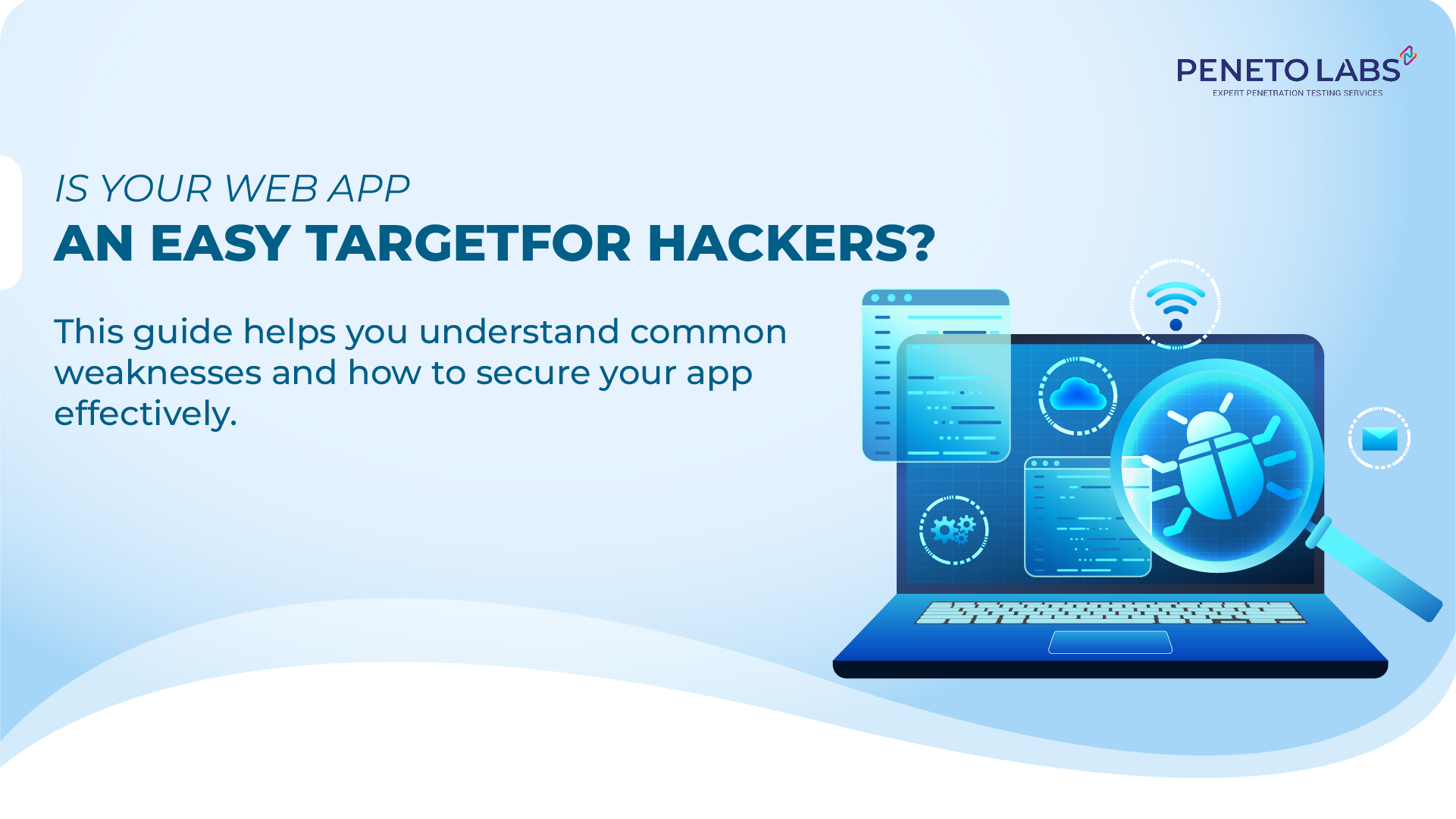Do you know how safe is your web application? You might know that a single vulnerability in your web app can lead to reputational and financial damage. This guide helps you understand common weaknesses and how to secure your app effectively.
Why Web Apps Are Frequent Hacker Targets?
- Web apps expose interfaces to the internet, making them visible targets.
- Hackers exploit logic flaws, weak authentication, and unpatched dependencies.
- If you collect user data or have login pages, your app is already attractive to attackers.
- Attacks like SQL Injection, cross-site scripting, and broken access controls remain top threats for web applications.
Common Vulnerabilities Cybercriminals Exploit in Web Apps
- Injection Attacks (SQLi, Command Injection): Inject malicious input into queries.
- Cross-Site Scripting (XSS): Embed harmful scripts in user-facing forms.
- Broken Authentication: Weak password policy, bypassable login paths, unprotected session tokens.
- Insecure Direct Object References (IDOR): Unauthorized users can access restricted data.
- Misconfiguration & Default Settings: Leaving debug tools, unused endpoints, or default credentials enabled.
How Can You Secure Your Web App from Potential Attacks?
Securing your web app starts with knowing your weak spots and fixing them before attackers find them. Here’s how you can proactively protect your application:
1. Regular Vulnerability Scanning & Penetration Testing
Utilize both automated scanners and manual penetration testing to identify and address hidden vulnerabilities. Manual testing helps you catch logic flaws, business logic issues, and complex attack paths that tools alone miss. Alwatys perform penetration testing before major releases.
2. Secure Your Code from Day One
Never assume your code is safe by default. Implement secure coding practices. Validate and sanitize all user inputs. Avoid using outdated libraries or plugins.
3. Use Strong Authentication & Session Protection
- Enforce multi-factor authentication (MFA).
- Limit session duration and auto-expire inactive sessions.
- Use HTTPS-only cookies, secure session IDs, and refresh tokens regularly.
- Never store passwords in plain text and use secure password policies.
- Weak logins and poor session handling can hand over your application to hackers.
4. Apply the Principle of Least Privilege (PoLP)
Give each user only the access they need to do their jobs, nothing more. Admins, employees, and third-party vendors should not have full control unless absolutely required. This minimizes damage if credentials get compromised.
5. Keep Everything Updated
Whether it’s your framework, CMS, or a tiny plugin, outdated software is a goldmine for hackers. Update your frameworks, libraries, CMS, and plugins. Patch regularly. Unpatched systems are a common entry point for hackers. Monitor CVEs for third-party tools you use. Use a vulnerability scanner to flag issues automatically.
6. Cover All Environments—Not Just Production
Breaches don’t wait for your app to go live. Always secure your development, staging, and beta environments as security risks exist in live, beta, or staging environments. Never skip full audits on non-production systems, which attackers can exploit. Always apply the same security standards across all environments. Don’t use real data on test servers without encryption and access controls.
7. Input Validation & Sanitization
Always validate and sanitize user inputs on the server side. Never rely solely on client-side validation—hackers can bypass it easily. Validate every piece of user input on the server side—don’t trust what comes from browsers. Use input filters, escape special characters, and enforce proper data types to prevent attacks like SQL injection and XSS.
8. Enforce End-to-End Security Practices
- Encrypt all traffic using SSL/TLS
- Tunnel and encrypt all remote access
- Log every access attempt to your infrastructure
- Monitor logs and unusual behavior across systems.
- Avoid mixed content warnings by making sure every resource loads securely
- Conduct audits after every major change in system architecture or business logic
- Keep detailed logs of user activities, failed login attempts, and changes in permissions. Monitor them for suspicious patterns.
9. Don’t Expose Technical Errors
Never display stack traces, database dumps, or backend errors to the end user. Hackers look for these clues to map your system. Log detailed errors internally and show generic messages externally.
10. Set Up a Security Response Plan
Have a documented incident response plan. Know how to act in case of a breach—who to notify, what to isolate, and how to report.
11. Security Headers & Content Policies
Use HTTP security headers like Content-Security-Policy, X-Frame-Options, and Strict-Transport-Security to harden your app.
12. Train Your Team
Integrate security into DevSecOps pipelines. Train your developers regularly to understand input validation, auth frameworks, and error handling. Maintain an asset inventory with versions, dependencies, and configurations.
Remember, security isn’t a one-time fix—it’s a continuous process. Don’t wait for a breach to happen. Review your current testing cycles and security posture now! Whether you’re a SaaS provider, BFSI, fintech company, or enterprise web vendor, security equals trust.
Need expert help to put all these security practices in place?
Peneto Labs offers manual and automated web app security testing, Safe-to-Host certification, and detailed, audit-ready reports. Our mature Web app pentesting process aligns with OWASP Top 10 and NIST Guidelines.
Get in touch today for a no-obligation initial audit and secure your web app before attackers do.
